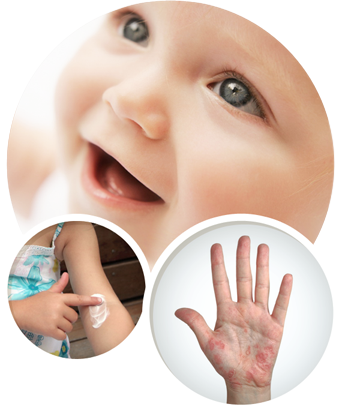What causes Atopic Skin And How Common Is It?
Atopic dermatitis, otherwise known as atopic eczema, is a very common dry skin condition that can affect almost anyone but tends to be most common amongst young children.
Fortunately, this type of eczema clears up in most cases by the age of 16. The condition comes in several levels of severity; mild symptoms include itchiness and redness while more severe symptoms include inflamed or dry cracked skin.


Atopic skin is an inflammatory condition that occurs when the skin's protective barrier becomes weak. When the skin’s natural oils and fats are low, skin cells are less able to retain hydration, which causes them to shrink. Hence, flaking and cracks increase. This causes moisture to be lost from the deeper layers of the skin, making it easier for bacteria and irritants to pass through. The skin can become red and inflamed on contact with allergens and everyday irritants.
Atopic skin can be dry and cracked and, in more severe cases, can be weepy and crusty.
Where Does Atopic Dermatitis Tend to Occur?
Atopic eczema usually occurs in small patches all over the body. The areas affected tend to vary by age.
For babies and infants, it often occurs on the face and scalp and the outer surface of the arms and legs
Atopic eczema in children tends to occur on the sensitive areas of skin around the joints, such as inside the elbow or back of the knees
With the adults, hands are often the most affected.
In the UK, atopic skin affects up to 1 in 5 children, while 8 out of 10 of these cases develop it by their fifth birthday*
*Source: www.netdoctor.co.uk/healthy-living/a-non-steroid-approach-to-eczema.htm, April 2013
You can find out more information about this condition from websites such as
How Can I Help Manage Atopic Skin?
In most cases, atopic dermatitis can be managed successfully by following the advice of your healthcare professional and following a specially designed skincare regime. Once you learn what triggers you or your child’s skin condition, you can take the necessary steps to establish an eczema skin care routine; by limiting external factors, you can avoid flare-ups and restore the wellness of your skin.
What Triggers Atopic Skin?
Though putting perfume may be a part of your daily routine, it can adversely affect your skin condition. Other external factors that can also irritate the skin and worsen your atopic skin condition include the following:
Perfumed products
Stress
Certain foods
Bubble baths
Hot weather
Cold weather
Develop a healthy atopic eczema skin care routine by noting down factors that may be triggering eczema for you or your child. Factors to note down and reflect on include:
Diet
Emotions
Weather
Toiletries used

Talk to your doctor, nurse or pharmacist about your or your child’s atopic dermatitis and products that may be able to help manage it.
Asking for help
There may also be a specialist skin clinic in your area that can give you more advice on managing atopic skin. Your healthcare professional should be able to give you more information about these clinics.
Using The Right Combination Of Products
It is important to use products made with emollients as they are specially formulated for cleansing and hydrating atopic skin. Emollient washes and creams work together to keep atopic skin moisturized and calmed throughout the day. For best results, use a combination of these products regularly, not just when the skin is particularly dry or sore, to moisturize and soothe atopic eczema.

Cleansing
With emollient washes, baths or oils.
Moisturising
With emollient creams, lotions or ointments

For moisturising
Creams and lotions
Soothing and moisturising can help to calm your skin during the day

For moisturising
Ointments
Rich and soothing, can be used at night to moisturise very dry skin

For washing
Bath and shower
Cleanse your skin gently and leave a layer of protective oil

For washing
Emollient washes
Use mild cleansers to gently wash your skin without drying it out
When using emollients it is important to remember:
Always use products that have been specifically developed for atopic dermatitis
To avoid irritating your skin, apply lotions and creams gently downwards in the direction of hair growth, as rubbing can further irritate the skin
Take warm showers or baths, as very hot water can further dry or irritate the skin
While emollients form the basis for management of dry and atopic-prone skin other products such as steroid creams and bandages may be prescribed during flare ups or in more severe cases. Steroid creams can be very potent and should only be used as prescribed by your healthcare professional in order to avoid unnecessarily thinning the skin.
Atopic dermatitis can sometimes lead to additional symptoms such as weeping, crusting, fever and the development of pustules. In this case, it is important to consult your healthcare professional for an appropriate treatment for eczema.
You may have to try several combinations of products before you find the one that is suitable for you or your child’s atopic skin. It’s always worth speaking to your healthcare professional if you feel that the products you are currently using aren’t working.
For more information about atopic skin please visit:
